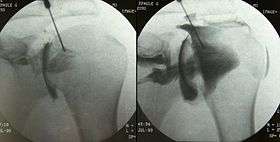Arthrogram
| Arthrogram | |
|---|---|
| Diagnostics | |
 | |
| ICD-9-CM | 88.32 |
| OPS-301 code | 3-13k |
An arthrogram is a series of images of a joint after injection of a contrast medium, usually done by fluoroscopy or MRI. The injection is normally done under a local anesthetic.The radiologist or radiographer performs the study using fluoroscopy or ultrasound to guide the placement of the needle into the joint and then injects an appropriate amount of contrast.
Related technologies
The physician or radiographer then obtains a series of X-rays, or alternatively Computed Tomography (CT) scans or Magnetic Resonance Imaging (MRI) scans. The joint can be imaged from many angles in fluoroscopy, or on a slice by slice basis in CT and MRI scans.
Use
Shoulder arthrography can be used to study tears of the rotator cuff, glenoid labrum and biceps.[1] The type of contrast injected into the joint depends on the subsequent imaging that is planned. For pneumoarthrography, gas is used, for CT or radiographs, a water-soluble radiopaque contrast, and for MRI, gadolinium. Double-contrast arthrography can be used for more anatomically complex cases, though its use is relatively infrequent. The needle is radiographically guided into the glenohumeral joint space, after which the patient is evaluated by fluoroscopy, CT or MRI. The gadolinium in the contrast fluid yields a bright signal on T1 weighted images allowing for better evaluation of the joint capsule, the articular surface of the bones and, in particular, the labral cartilage. MR arthrography is most often used in evaluation of the hip and acetabular labrum, of the shoulder rotator cuff and glenoid labrum, and less often in the wrist.[1] Arthrograms can be diagnostic and therapeutic. Therapeutic arthrograms often distend the joint with cortisone and lidocaine, with a common site being the shoulder. Diagnostic arthrograms can be direct, as described above with penetration of the joint, or indirect, by a venous injection of contrast material and delayed imaging with CT or MRI.[1]
Risks
Patients who are allergic to or sensitive to medications, contrast dyes, local anesthesia, iodine, or latex should not have this procedure. Potential risks are infections at the puncture site where the radiopaque substance and/or air are injected. Bleeding is also a small risk. Rarely, nephrogenic systemic fibrosis (NSF) can occur in patients with impaired renal function who receive gadolinium, a debilitating and potentially fatal disease affecting skin, muscle, and internal organs.[2]
See also
References
- 1 2 3 R. Crim, Julia, Specialty Imaging: Arthrography: Principles and Practice in Radiology, Lippincott Williams & Wilkins, ISBN 978-1-931884-15-0
- ↑ Bloom, Mark (22 December 2006), Medical News: FDA Issues Alert on Gadolinium-Based Contrast Agent for Kidney Patients, Nephrology, General Nephrology, MedPage Today, retrieved 2009-05-05